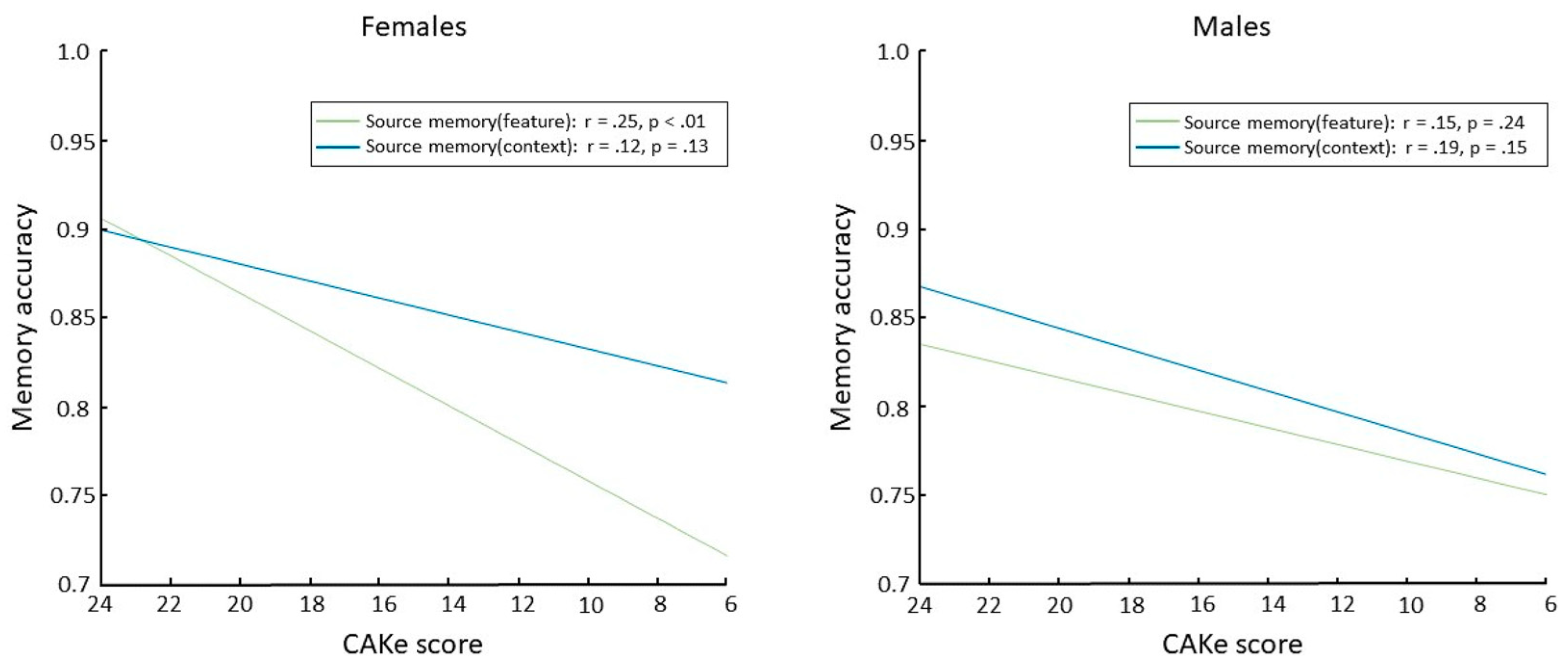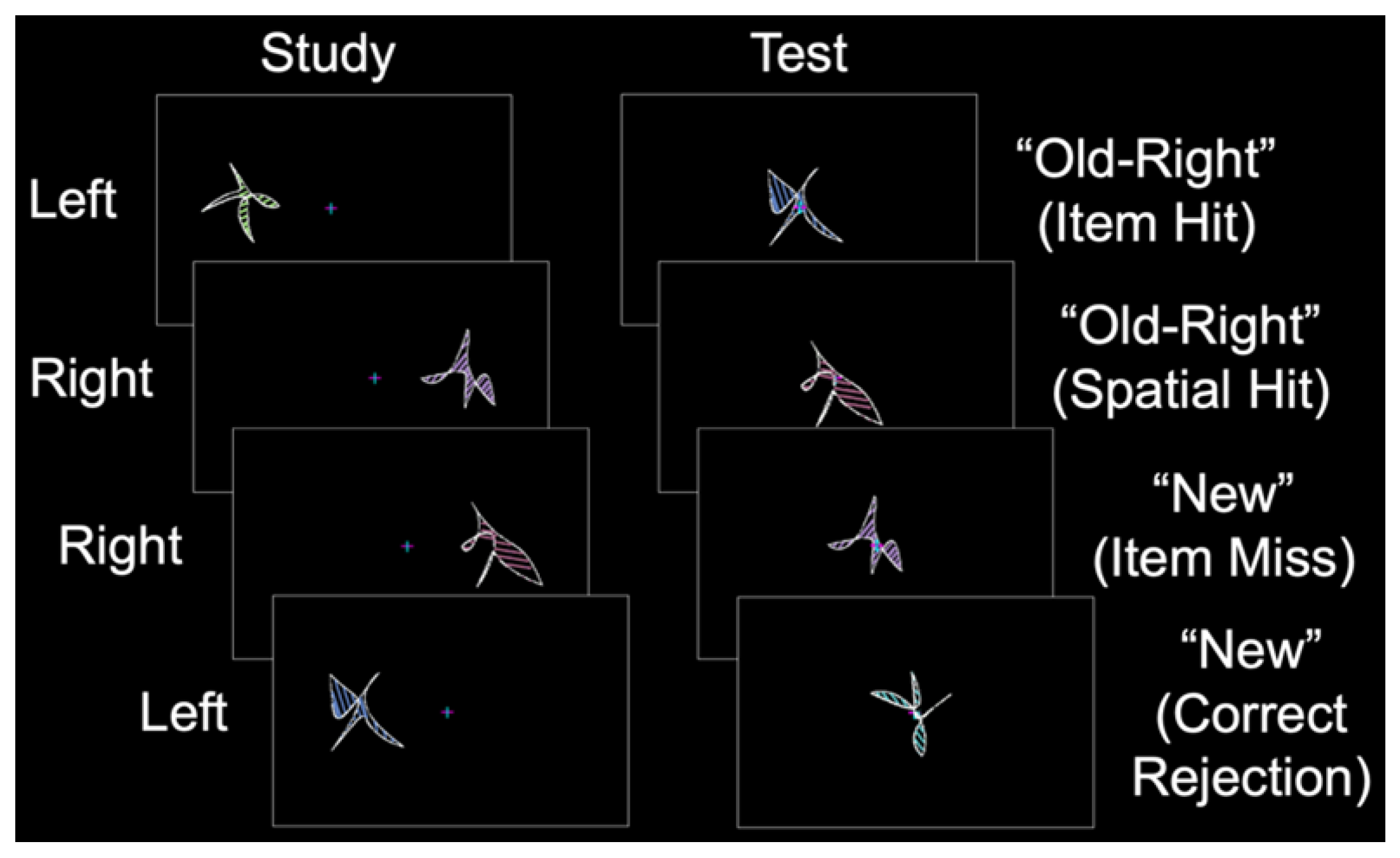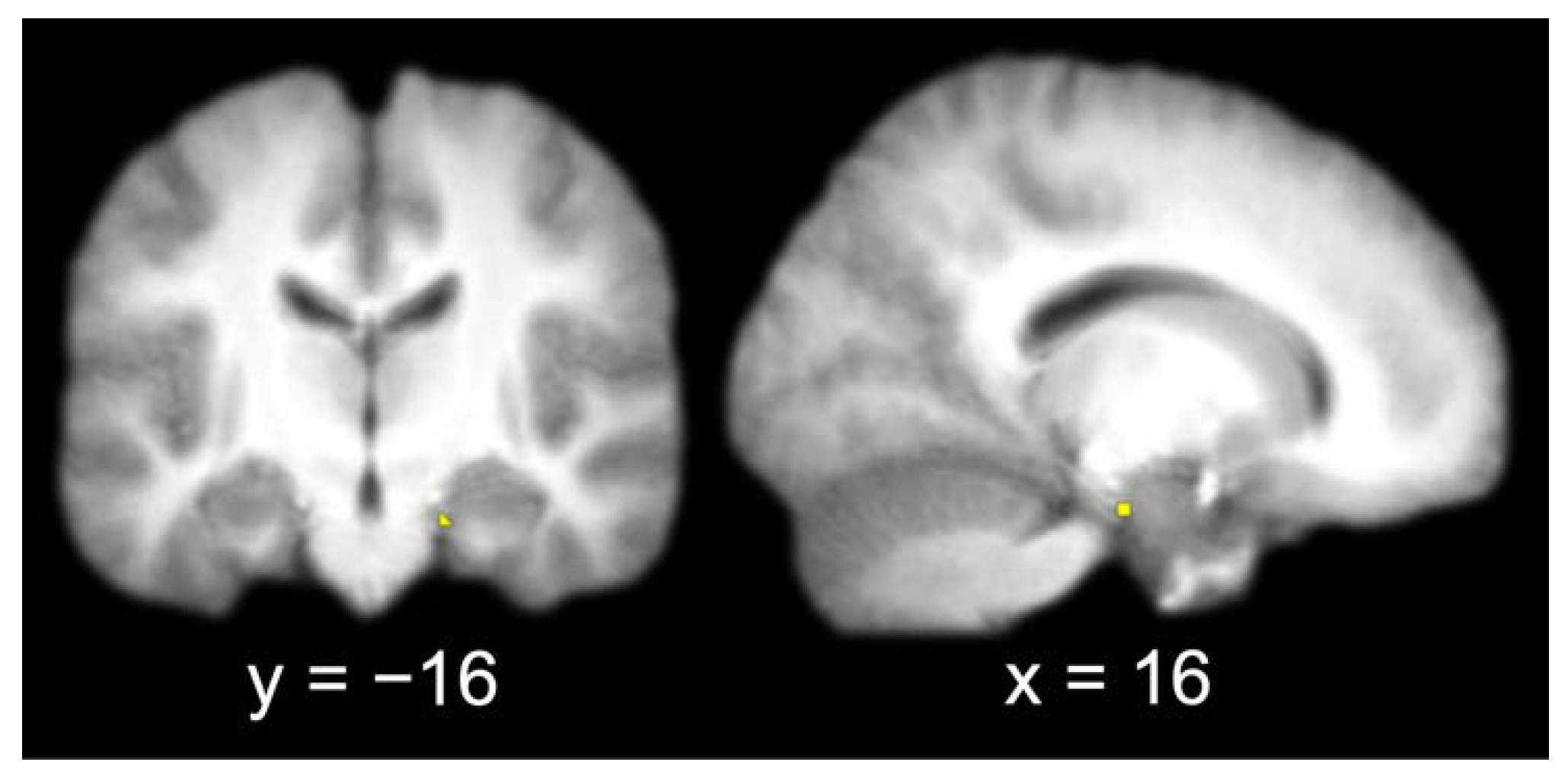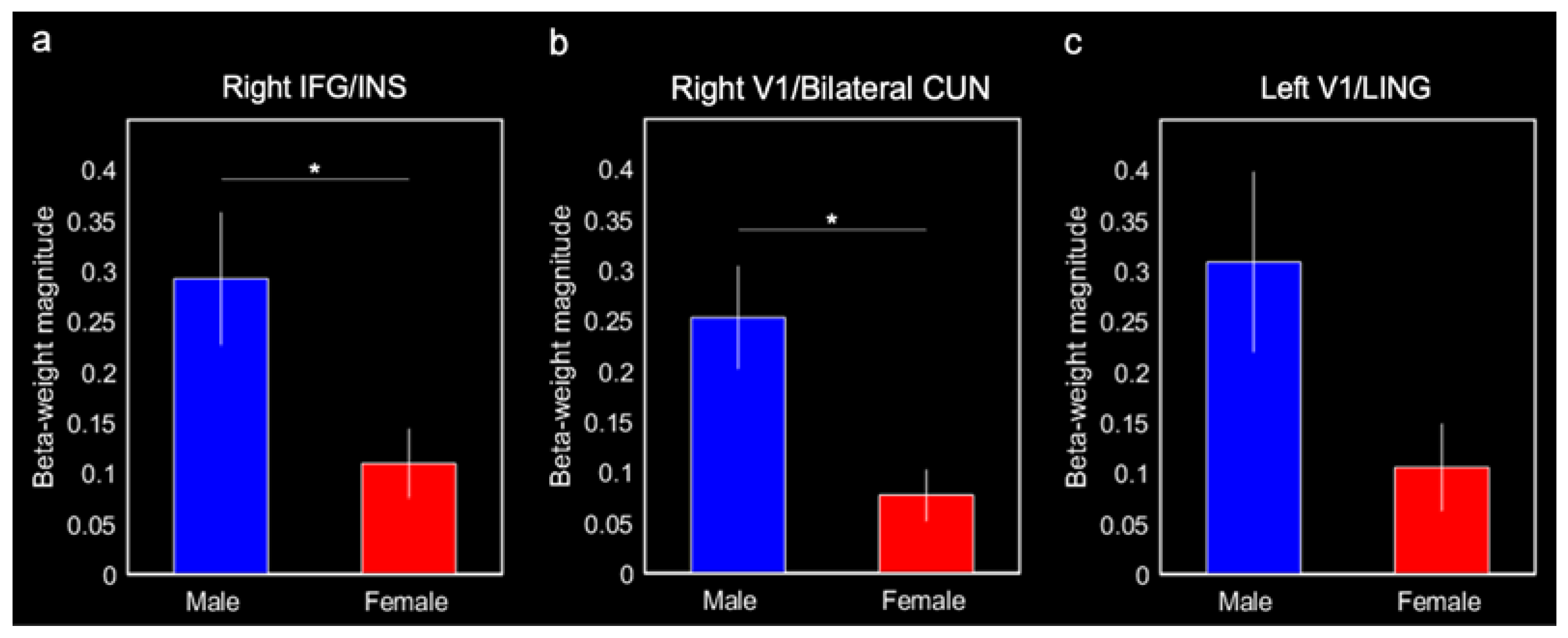Entorhinal Cortex Functional Connectivity during Item Long-Term Memory and the Role of Sex
Abstract
:1. Introduction
2. Materials and Methods
2.1. Participants
2.2. Stimulus Protocol and Task
2.3. Experimental Design
2.4. Image Acquisition and Analysis
3. Results
4. Discussion
5. Conclusions
Author Contributions
Funding
Institutional Review Board Statement
Informed Consent Statement
Data Availability Statement
Acknowledgments
Conflicts of Interest
References
- Eichenbaum, H.; Yonelinas, A.P.; Ranganath, C. The medial temporal lobe and recognition memory. Annu. Rev. Neurosci. 2007, 30, 123–152. [Google Scholar] [CrossRef] [PubMed] [Green Version]
- Diana, R.A.; Yonelinas, A.P.; Ranganath, C. Imaging recollection and familiarity in the medial temporal lobe: A three-component model. Trends Cogn. Sci. 2007, 11, 379–386. [Google Scholar] [CrossRef]
- Goldstein, J.M.; Seidman, L.J.; Horton, N.; Makris, N.; Kennedy, D.N.; Caviness, V.S.; Faraone, S.; Tsuang, M.T. Normal sexual dimorphism of the adult human brain assessed by in vivo magnetic resonance imaging. Cereb. Cortex 2001, 11, 490–497. [Google Scholar] [CrossRef]
- Spets, D.S.; Fritch, H.A.; Slotnick, S.D. Sex differences in hippocampal connectivity during spatial long-term memory. Hippocampus 2021, 31, 669–676. [Google Scholar] [CrossRef]
- Spets, D.S.; Jeye, B.M.; Slotnick, S.D. Different patterns of cortical activity in females and males during spatial long-term memory. Neuroimage 2019, 199, 626–634. [Google Scholar] [CrossRef]
- Spets, D.S.; Slotnick, S.D. Are there sex differences in brain activity during long-term memory? A systematic review and fMRI activation likelihood estimation meta-analysis. Cogn. Neurosci. 2021, 12, 163–173. [Google Scholar] [CrossRef] [PubMed]
- Spets, D.S.; Slotnick, S.D. Similar patterns of cortical activity in females and males during item memory. Brain Cogn. 2019, 135, 103581. [Google Scholar] [CrossRef] [PubMed]
- Ingalhalikar, M.; Smith, A.; Parker, D.; Satterthwaite, T.D.; Elliott, M.A.; Ruparel, K.; Hakonarson, H.; Gur, R.E.; Gur, R.C.; Verma, R. Sex differences in the structural connectome of the human brain. Proc. Natl. Acad. Sci. USA 2014, 111, 823–828. [Google Scholar] [CrossRef] [Green Version]
- Ritchie, S.J.; Cox, S.R.; Shen, X.; Lombardo, M.V.; Reus, L.M.; Alloza, C.; A Harris, M.; Alderson, H.L.; Hunter, S.; Neilson, E.; et al. Sex Differences in the Adult Human Brain: Evidence from 5216 UK Biobank Participants. Cereb. Cortex 2018, 28, 2959–2975. [Google Scholar] [CrossRef]
- Wang, L.; LaViolette, P.; O’Keefe, K.; Putcha, D.; Bakkour, A.; Van Dijk, K.R.; Pihlajamäki, M.; Dickerson, B.C.; Sperling, R.A. Intrinsic connectivity between the hippocampus and posteromedial cortex predicts memory performance in cognitively intact older individuals. Neuroimage 2010, 51, 910–917. [Google Scholar] [CrossRef] [Green Version]
- Dunn, C.J.; Duffy, S.L.; Hickie, I.; Lagopoulos, J.; Lewis, S.; Naismith, S.L.; Shine, J. Deficits in episodic memory retrieval reveal impaired default mode network connectivity in amnestic mild cognitive impairment. Neuroimage Clin. 2014, 4, 473–480. [Google Scholar] [CrossRef] [PubMed]
- Voets, N.L.; Zamboni, G.; Stokes, M.G.; Carpenter, K.; Stacey, R.; Adcock, J.E. Aberrant functional connectivity in dissociable hippocampal networks is associated with deficits in memory. J. Neurosci. 2014, 34, 4920–4928. [Google Scholar] [CrossRef] [Green Version]
- Leal, S.L.; Yassa, M.A. Perturbations of neural circuitry in aging, mild cognitive impairment, and Alzheimer’s disease. Ageing Res. Rev. 2013, 12, 823–831. [Google Scholar] [CrossRef] [PubMed] [Green Version]
- Braak, H.; Braak, E. Neuropathological stageing of Alzheimer-related changes. Acta Neuropathol. 1991, 82, 239–259. [Google Scholar] [CrossRef] [PubMed]
- Braak, H.; Braak, E. Frequency of stages of Alzheimer-related lesions in different age categories. Neurobiol. Aging 1997, 18, 351–357. [Google Scholar] [CrossRef]
- Thal, D.R.; Rüb, U.; Orantes, M.; Braak, H. Phases of A beta-deposition in the human brain and its relevance for the development of AD. Neurology 2002, 58, 1791–1800. [Google Scholar] [CrossRef]
- Scheyer, O.; Rahman, A.; Hristov, H.; Berkowitz, C.; Isaacson, R.S.; Diaz Brinton, R.; Mosconi, L. Female Sex and Alzheimer’s Risk: The Menopause Connection. J. Prev. Alzheimers Dis. 2018, 5, 225–230. [Google Scholar] [CrossRef] [PubMed]
- Fritch, H.A.; Moo, L.R.; Sullivan, M.A.; Thakral, P.P.; Slotnick, S.D. Impaired cognitive performance in older adults is associated with deficits in item memory and memory for object features. Brain Cogn. 2023, 166, 105957. [Google Scholar] [CrossRef]
- Park, H.; Abellanoza, C.; Schaeffer, J.; Gandy, K. Source recognition by stimulus content in the MTL. Brain Res. 2014, 1553, 59–68. [Google Scholar] [CrossRef]
- Park, H.; Leal, F.; Spann, C.; Abellanoza, C. The effect of object processing in content-dependent source memory. BMC Neurosci. 2013, 14, 71. [Google Scholar] [CrossRef] [Green Version]
- Staresina, B.P.; Davachi, L. Selective and shared contributions of the hippocampus and perirhinal cortex to episodic item and associative encoding. J. Cogn. Neurosci. 2008, 20, 1478–1489. [Google Scholar] [CrossRef] [Green Version]
- Davachi, L.; Mitchell, J.P.; Wagner, A.D. Multiple routes to memory: Distinct medial temporal lobe processes build item and source memories. Proc. Natl. Acad. Sci. USA 2003, 100, 2157–2162. [Google Scholar] [CrossRef] [PubMed] [Green Version]
- Slotnick, S.D.; Schacter, D.L. A sensory signature that distinguishes true from false memories. Nat. Neurosci. 2004, 7, 664–672. [Google Scholar] [CrossRef] [PubMed]
- Slotnick, S.D.; Schacter, D.L. The nature of memory related activity in early visual areas. Neuropsychologia 2006, 44, 2874–2886. [Google Scholar] [CrossRef]
- Macmillian, N.A.; Creelman, C.D. Detection Theory: A User’s Guide; Cambridge University Press: New York, NY, USA, 2004. [Google Scholar]
- Power, J.D.; Barnes, K.A.; Snyder, A.Z.; Schlaggar, B.L.; Petersen, S.E. Spurious but systematic correlations in functional connectivity MRI networks arise from subject motion. Neuroimage 2012, 59, 2142–2154. [Google Scholar] [CrossRef] [Green Version]
- Spets, D.S.; Slotnick, S.D. Thalamic Functional Connectivity during Spatial Long-Term Memory and the Role of Sex. Brain Sci. 2020, 10, 898. [Google Scholar] [CrossRef]
- McLaren, D.G.; Ries, M.L.; Xu, G.; Johnson, S.C. A generalized form of context-dependent psychophysiological interactions (gPPI): A comparison to standard approaches. Neuroimage 2012, 61, 1277–1286. [Google Scholar] [CrossRef] [PubMed] [Green Version]
- Slotnick, S.D. Cluster success: FMRI inferences for spatial extent have acceptable false-positive rates. Cogn. Neurosci. 2017, 8, 150–155. [Google Scholar] [CrossRef]
- Whitfield-Gabrieli, S. Region of Interest Extraction (REX) Toolbox; Boston, MA, USA, 2009. Available online: https://web.mit.edu/swg/software.htm (accessed on 10 February 2023).
- Gennatas, E.D.; Avants, B.B.; Wolf, D.H.; Satterthwaite, T.D.; Ruparel, K.; Ciric, R.; Hakonarson, H.; Gur, R.E.; Gur, R.C. Age-Related Effects and Sex Differences in Gray Matter Density, Volume, Mass, and Cortical Thickness from Childhood to Young Adulthood. J. Neurosci. 2017, 37, 5065–5073. [Google Scholar] [CrossRef] [Green Version]
- Lenroot, R.K.; Gogtay, N.; Greenstein, D.K.; Wells, E.M.; Wallace, G.L.; Clasen, L.S.; Blumenthal, J.D.; Lerch, J.; Zijdenbos, A.P.; Evans, A.C.; et al. Sexual dimorphism of brain developmental trajectories during childhood and adolescence. Neuroimage 2007, 36, 1065–1073. [Google Scholar] [CrossRef] [Green Version]
- Koolschijn, C.; Crone, E.A. Sex differences and structural brain maturation from childhood to early adulthood. Dev. Cogn. Neurosci. 2013, 5, 106–118. [Google Scholar] [CrossRef] [PubMed]
- Andreano, J.M.; Cahill, L. Sex influences on the neurobiology of learning and memory. Learn. Mem. 2009, 16, 248–266. [Google Scholar] [CrossRef] [Green Version]
- Hickok, G.; Poeppel, D. The cortical organization of speech processing. Nat. Rev. Neurosci. 2007, 8, 393–402. [Google Scholar] [CrossRef]
- Corballis, M. Visuospatial processing and the right-hemisphere interpreter. Brain Cogn. 2003, 53, 171–176. [Google Scholar] [CrossRef] [PubMed]
- Takehara-Nishiuchi, K. Entorhinal cortex and consolidated memory. Neurosci. Res. 2014, 84, 27–33. [Google Scholar] [CrossRef]
- Burwell, R.D.; Amaral, D.G. Perirhinal and postrhinal cortices of the rat: Interconnectivity and connections with the entorhinal cortex. J. Comp. Neurol. 1998, 391, 293–321. [Google Scholar] [CrossRef]
- Miyashita, Y. Perirhinal circuits for memory processing. Nat. Rev. Neurosci. 2019, 20, 577–592. [Google Scholar] [CrossRef]
- Despouy, E.; Curot, J.; Deudon, M.; Gardy, L.; Denuelle, M.; Sol, J.-C.; Lotterie, J.-A.; Valton, L.; Barbeau, E.J. A Fast Visual Recognition Memory System in Humans Identified Using Intracerebral ERP. Cereb. Cortex 2020, 30, 2961–2971. [Google Scholar] [CrossRef] [PubMed]





| Region | BA | x | y | z | k |
|---|---|---|---|---|---|
| R. IFG/Insula | 44 | 47 | 18 | 8 | 75 |
| R. V1/Bilateral Cuneus | 17/18 | 5 | −68 | 13 | 107 |
| L. V1/Lingual Gyrus | 17/18 | −10 | −58 | 7 | 49 |
| R. Putamen/Insula | − | 28 | 13 | 4 | 53 |
| R. Putamen | − | 19 | 13 | −7 | 47 |
Disclaimer/Publisher’s Note: The statements, opinions and data contained in all publications are solely those of the individual author(s) and contributor(s) and not of MDPI and/or the editor(s). MDPI and/or the editor(s) disclaim responsibility for any injury to people or property resulting from any ideas, methods, instructions or products referred to in the content. |
© 2023 by the authors. Licensee MDPI, Basel, Switzerland. This article is an open access article distributed under the terms and conditions of the Creative Commons Attribution (CC BY) license (https://creativecommons.org/licenses/by/4.0/).
Share and Cite
Spets, D.S.; Slotnick, S.D. Entorhinal Cortex Functional Connectivity during Item Long-Term Memory and the Role of Sex. Brain Sci. 2023, 13, 446. https://doi.org/10.3390/brainsci13030446
Spets DS, Slotnick SD. Entorhinal Cortex Functional Connectivity during Item Long-Term Memory and the Role of Sex. Brain Sciences. 2023; 13(3):446. https://doi.org/10.3390/brainsci13030446
Chicago/Turabian StyleSpets, Dylan S., and Scott D. Slotnick. 2023. "Entorhinal Cortex Functional Connectivity during Item Long-Term Memory and the Role of Sex" Brain Sciences 13, no. 3: 446. https://doi.org/10.3390/brainsci13030446
APA StyleSpets, D. S., & Slotnick, S. D. (2023). Entorhinal Cortex Functional Connectivity during Item Long-Term Memory and the Role of Sex. Brain Sciences, 13(3), 446. https://doi.org/10.3390/brainsci13030446





